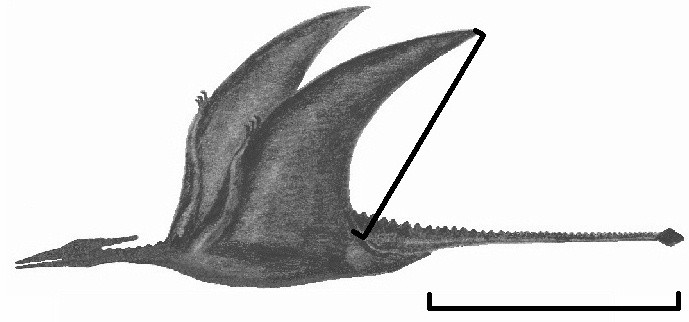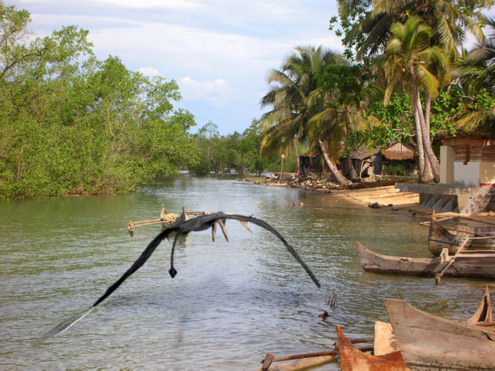Post by MoMo on Mar 11, 2012 19:14:32 GMT -6
Ropen

Grouping: Cryptid
Sub grouping: Living Pterosaur
First reported: Unknown
Country: Papua New Guinea
Region: Umboi Island
Habitat: Jungle
The Ropen is a flying cryptid alleged to live in the vicinity of Papua New Guinea. According to the book Searching for Ropens, it is "any featherless creature that flies in the Southwest Pacific, and has a tail-length more than 25% of its wingspan." On Umboi Island the word "ropen" refers to a large nocturnal creature that glows briefly as it flies. The ropen is the subject of folklore (like a man but also like a spirit) but it's believed by some natives to be a real animal. Descriptions vary, but it is often said to be batlike, and sometimes, Pterosaur-like; although pterosaurs are generally accepted to have been extinct for 65 million years. The ropen is believed to be nocturnal and to exhibit bioluminescence. Purportedly it lives on a diet of fish, though there have been some reports of the creature feasting on human flesh, especially grave robbery.


Investigations
As an attempt to discredit mainstream scientific views on the age of the Earth, several expeditions have been embarked upon by American creationists, including Carl Baugh, Paul Nation, Jonathan Whitcomb, David Woetzel, and Garth Guessman.
In late 2006, Paul Nation, of Texas, explored a remote mountainous area on the mainland of Papua New Guinea. He videotaped two lights that the local natives called "indava." Nation believed the lights were from the bioluminescence of creatures similar to the ropen of Umboi Island. The video was analyzed by a missile defense physicist who reported that the two lights on the video were not from any fires, meteors, airplanes or camera artifacts. He also reported that the image of the two lights was authentic and was not manipulated or hoaxed.
In 2007, cryptid investigator Joshua Gates went to Papua New Guinea in search of the Ropen for his TV show Destination Truth. He and his team also witnessed strange lights at night and could not confirm what they were.
In 2009, the television show Monster Quest conducted an expedition in search of the "demon flyer" but found no evidence of the creature. Later, they had a forensic video analyst examine the Paul Nation video. The analyst could not definitely conclude what was causing the lights, but ruled out vehicles and campfires believing the footage was of a pair of bioluminescent creatures perched in a tree that later take flight.
Identity
As is often the case with cryptids, the Ropen's true identity is subject to debate. Some believe it to be a pterodactyl-like creature, while others suggest that the Ropen is a misidentified bat (e.g. flying foxes, which are large fruit bats than can have wingspans up to two metres (six feet), or frigatebird. Flying lights in Papua New Guinea have been reported by not only natives but by Western visitors. Evelyn Cheesman, the entomologist, mentions them in her book The Two Roads of Papua (published in 1935): "baffling" lights that lasted "about four or five seconds." The book Searching for Ropens says that the "ropen" light of Umboi Island lasts for about "five seconds." There is also said to be a creature called "Duah" that is said to be another kind of ropen, but according to Searching for Ropens the correct word is actually "duwas," and it is just another name, in a different language, for the same creature.




Grouping: Cryptid
Sub grouping: Living Pterosaur
First reported: Unknown
Country: Papua New Guinea
Region: Umboi Island
Habitat: Jungle
The Ropen is a flying cryptid alleged to live in the vicinity of Papua New Guinea. According to the book Searching for Ropens, it is "any featherless creature that flies in the Southwest Pacific, and has a tail-length more than 25% of its wingspan." On Umboi Island the word "ropen" refers to a large nocturnal creature that glows briefly as it flies. The ropen is the subject of folklore (like a man but also like a spirit) but it's believed by some natives to be a real animal. Descriptions vary, but it is often said to be batlike, and sometimes, Pterosaur-like; although pterosaurs are generally accepted to have been extinct for 65 million years. The ropen is believed to be nocturnal and to exhibit bioluminescence. Purportedly it lives on a diet of fish, though there have been some reports of the creature feasting on human flesh, especially grave robbery.


Investigations
As an attempt to discredit mainstream scientific views on the age of the Earth, several expeditions have been embarked upon by American creationists, including Carl Baugh, Paul Nation, Jonathan Whitcomb, David Woetzel, and Garth Guessman.
In late 2006, Paul Nation, of Texas, explored a remote mountainous area on the mainland of Papua New Guinea. He videotaped two lights that the local natives called "indava." Nation believed the lights were from the bioluminescence of creatures similar to the ropen of Umboi Island. The video was analyzed by a missile defense physicist who reported that the two lights on the video were not from any fires, meteors, airplanes or camera artifacts. He also reported that the image of the two lights was authentic and was not manipulated or hoaxed.
In 2007, cryptid investigator Joshua Gates went to Papua New Guinea in search of the Ropen for his TV show Destination Truth. He and his team also witnessed strange lights at night and could not confirm what they were.
In 2009, the television show Monster Quest conducted an expedition in search of the "demon flyer" but found no evidence of the creature. Later, they had a forensic video analyst examine the Paul Nation video. The analyst could not definitely conclude what was causing the lights, but ruled out vehicles and campfires believing the footage was of a pair of bioluminescent creatures perched in a tree that later take flight.
Identity
As is often the case with cryptids, the Ropen's true identity is subject to debate. Some believe it to be a pterodactyl-like creature, while others suggest that the Ropen is a misidentified bat (e.g. flying foxes, which are large fruit bats than can have wingspans up to two metres (six feet), or frigatebird. Flying lights in Papua New Guinea have been reported by not only natives but by Western visitors. Evelyn Cheesman, the entomologist, mentions them in her book The Two Roads of Papua (published in 1935): "baffling" lights that lasted "about four or five seconds." The book Searching for Ropens says that the "ropen" light of Umboi Island lasts for about "five seconds." There is also said to be a creature called "Duah" that is said to be another kind of ropen, but according to Searching for Ropens the correct word is actually "duwas," and it is just another name, in a different language, for the same creature.









